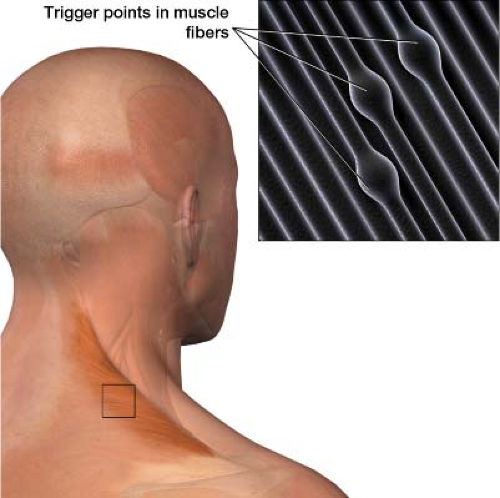Trigger Point Injections for Myofascial Pain
In order for a muscle to contract, actin and myosin strands slide over each other. These filaments then release, sliding back to their starting position. A taught muscle band is a part of the muscle where the contraction cannot release. A trigger point is a painful taut muscle band (Fig. 22-1). According to experts, an abnormal neuromuscular junction may lead to the development of this. The neuromuscular junction, where the nerve transmits signals to the muscle, is a highly excitable region, where each strand of muscle tissue obtains information on when to contract. If this charged, hyperexcitable region becomes overexcited, those muscle filaments remain contracted. Evidently, this contracted muscle state causes an increased metabolic demand and region of local ischemia. It may help to think of static cling in pants as an analogy for overcontraction. Too much electric charge causes pants to bunch up in some areas instead of lying flat.
Trigger points often cause regional persistent pain that can result in decreased range of motion. They commonly develop along the weight-bearing axial skeleton used to maintain body posture such as the neck, shoulder, or back. Skeletal muscle is subject to wear and tear just like the bones, joints, and bursa, which predisposes it to pathologic changes. Palpation of the trigger point elicits pain at the affected area and/or causes radiation of pain toward a zone of reference.1 Trigger points are a clinical diagnosis—there is no specific laboratory test, imaging study, or interventional modality such as EMG or muscle biopsy useful in establishing a diagnosis.2 By palpating the region of pain with your finger pad, specific trigger points can often be identified by verbal confirmation from the patient. A patient may have one or a multitude of trigger points.
Trigger point injections are thought to diffuse the abnormal electrical charge at the neuromuscular junction; this leads to restoration of normal muscle contraction sequelae. A variety of fluids have been injected into trigger points over the years including saline, local anesthetic, corticosteroids, Vitamin B solution, ketorolac (a nonsteroidal anti-inflammatory drug [NSAID]), and botulinum toxin. Usually a local anesthetic such as 2% lidocaine or 0.5% bupivacaine, or a combination of both, is used.
Currently, there is no consensus on the benefit of injecting any of these solutions over dry needling. Dry needling is the practice of breaking up the taut muscle band and diffusing the abnormal neuromuscular junction without injecting solution. In the United States, a local anesthetic is typically used because it may provide benefit by reducing pain and irritation caused by the needling itself.3 In one study, patients who underwent
trigger point injections with lidocaine and participated in physical therapy had less pain at 4-week follow-up as compared with the control group that underwent trigger point injections with dry needling and also participated in physical therapy.4 Using botulinum toxin type A in varying strengths showed no advantage over using a local anesthetic.4 In clinical practice some doctors also include a steroid to cure any local inflamation contributing to the trigger point.
trigger point injections with lidocaine and participated in physical therapy had less pain at 4-week follow-up as compared with the control group that underwent trigger point injections with dry needling and also participated in physical therapy.4 Using botulinum toxin type A in varying strengths showed no advantage over using a local anesthetic.4 In clinical practice some doctors also include a steroid to cure any local inflamation contributing to the trigger point.

Full access? Get Clinical Tree









